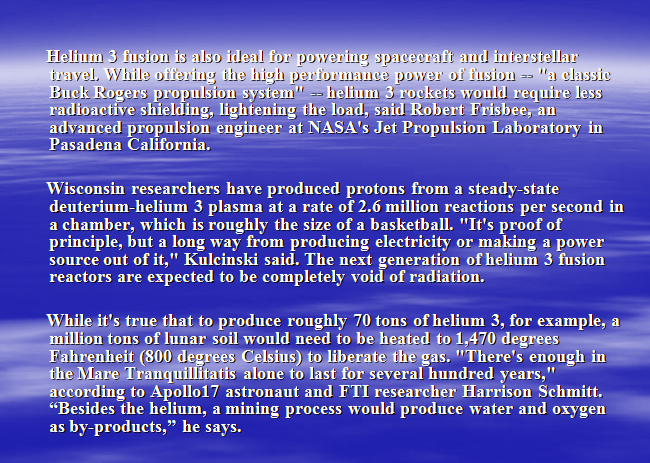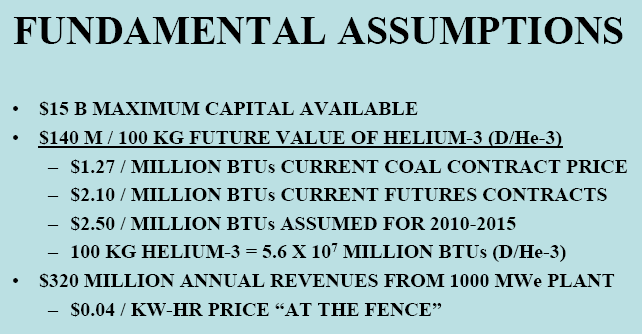- UWFDM-730 The Moon: An Abundant Source of Clean and Safe Fusion Fuel for the 21st Century; G.L. Kulcinski and H.H. Schmitt, August 1987 [Presented at the 11th International Scientific Forum on Fueling the 21st Century, 29 Sept.-6 October 1987, Moscow, USSR.]. (38 pages, 6.2 MB)
- UWFDM-817 Mining Helium-3 from the Moon - A Solution to the Earth's Energy Needs in the 21st Century; G.L. Kulcinski, H.H. Schmitt, E.N. Cameron, I.N. Sviatoslavsky, November 1989 [presented at the 1990 SME Annual Meeting, 26 February - 1 March 1990, Salt Lake City UT]. (13 pages, 2.1 MB)
- UWFDM-826 Fusion Power from Lunar Resources; G.L. Kulcinski and H.H. Schmitt, October 1990 (revised September 1991) [presented at the 41st Congress of the International Astronautical Federation, Dresden, Germany, 6-12 October 1990. To be published in Fusion Technology]. (25 pages, 625 kB)
- UWFDM-1000 Interlune-Intermars Business Intiative: Returning to Deep Space; H.H. Schmitt, April 1997 [published in Journal of Aerospace Engineering, April 1997, pp. 60-67]. (10 pages, 1.4 MB)
- UWFDM-1113 Origin and Evolution of the Moon: Apollo 2000 Model; H.H. Schmitt, September 1999 [Presented at New Views of the Moon II, Flagstaff AZ, 22-24 September 1999]. (8 pages, 133 kB)
- UWFDM-1120 Solar-Wind Hydrogen at the Lunar Poles; H.H. Schmitt, G.L. Kulcinski, J.F. Santarius, J. Ding, M.J. Malecki, M.J. Zalewski, February 2000 [Presented at SPACE 2000, The Seventh International Conference and Exposition on Engineering, Construction, Operations, and Business in Space, Albuquerque NM, 27 February - 2 March 2000; published in the Proceedings, pp. 653-660]. (11 pages, 204 kB)
- UWFDM-1121 Source and Implications of Large Lunar Basin-Forming Objects; H.H. Schmitt, March 2000 [Presented at the 31st Lunar and Planetary Science Conference, Houston TX, 13-17 March 2000]. (4 pages, 83 kB)
- UWFDM-1122 Contrary Views of the Origin and Thermal Evolution of the Moon; H.H. Schmitt, March 2000 [Presented at the 31st Lunar and Planetary Science Conference, Houston TX, 13-17 March 2000]. (21 pages, 2.4 MB)
- UWFDM-1131 Nuclear Power Without Radioactive Waste - The Promise of Lunar Helium-3; G.L. Kulcinski and H.H. Schmitt, July 2000 [presented at the Second Annual Lunar Development Conference, ``Return to the Moon II'', 20-21 July 2000, Las Vegas NV]. (9 pages, 228 kB)
- UWFDM-1187 Lunar Cataclysm? Depends On What ``Cataclysm'' Means; Harrison H. Schmitt, March 2001 [Paper \#1133, 32nd Lunar and Planetary Conference, 12-16 March 2001, Houston TX]. (4 pages, 537 kB)
- UWFDM-1189 A Lunar Field Geologist's Perspective 30 Years Later: Shocking Revelations About the Moon, Mars and Earth; Harrison H. Schmitt, October 2002 [2002 G.K. Gilbert Lecture, Annual Meeting and Exposition of the Geological Society of America, Planetary Geology Division, 27-30 October 2002, Denver CO]. (11 pages, 1.2 MB)
- UWFDM-1190 Return to the Moon; Harrison H. Schmitt, December 2002 [Accepted essay for a forthcoming book, ``Our Worlds 2,'' edited by Alan Stern]. (10 pages, 907 kB)
- UWFDM-1191 Business Approach To Lunar Base Activation; Harrison H. Schmitt, December 2002 [accepted by the Space Technology and Applications International Forum (STAIF-2003), 2-5 February 2003, Albuquerque NM]. (8 pages, 750 kB)
- UWFDM-1192 Business Context of Space Tourism; Harrison H. Schmitt, December 2002 [accepted by the Space Technology and Applications International Forum (STAIF-2003), 2-5 February 2003, Albuquerque NM]. (6 pages, 594 kB)
- UWFDM-1259 Large Energy Development Projects: Lessons Learned from Space and Politics; H.H. Schmitt, September 2004 [Proceedings 16th ANS Topical Meeting on Fusion Energy, Fusion Science and Technology 47 (3), April 2005, pp. 279-290]. (15 pages, 827 kB)
- WCSAR-TR-AR3-8901-1 Legal Regimes for the Mining of Helium-3 from the Moon; R.B. Bilder, E.N. Cameron, G.L. Kulcinski, H.H. Schmitt, February 1989 (revised July 1989). (117 pages, 8.3 MB)
- WCSAR-TR-AR3-9012-1 Net Environmental Aspects of Helium-3 Mining - Phase I: Effect on the Moon; E.N. Cameron, W.D. Carrier III, G.L. Kulcinski, H.H. Schmitt, October 1989 (revised December 1990). (88 pages, 9.2 MB)
- WCSAR-TR-AR3-9107-2 Fusion Power from Lunar Resources; G.L. Kulcinski, H.H. Schmitt, October 1991 [Published in Fusion Technology, Special Issue on DHe3 Fusion, Vol. 21 (4) 2221-2229]. (11 pages, 1.6 MB)
- WCSAR-TR-AR3-9201-5 Environmental Aspects of Lunar Helium-3 Mining; G.L. Kulcinski, E.N. Cameron, W.D. Carrier III, H.H. Schmitt, January 1992 [prepared for Space 92, The Third International Conference on Engineering, Construction, and Operations in Space, 31 May-4 June 1992, Denver CO]. (13 pages, 208 kB)
- WCSAR-TR-AR3-9203-1 Spiral Mining for Lunar Volatiles; H.H. Schmitt, G.L. Kulcinski, I.N. Sviatoslavsky, W.D. Carrier III, March 1992 [prepared for Space 92, The Third International Conference on Engineering, Construction, and Operations in Space, 31 May-4 June 1992, Denver CO]. (11 pages, 959 kB)
- WCSAR-TR-AR3-9203-2 INTERLUNE Concept for Helium-3 Lunar Development; H.H. Schmitt, March 1992 [prepared for Space 92, The Third International Conference on Engineering, Construction, and Operations in Space, 31 May-4 June 1992, Denver CO]. (13 pages, 1.1 MB)
- WCSAR-TR-AR3-9304-2 Helium-3: The Space Connection; H.H. Schmitt and G.L. Kulcinski, April 1993 [presented at the 9th National Space Symposium, Colorado Springs CO, 13-16 April 1993]. (31 pages, 1.4 MB)
- Early Lunar Impact Events: Terrestrial and Solar System Implication; H.H. Schmitt, October 1999 [Presented at the Geological Society of America 1999 Annual Meeting and Exposition, Denver CO, 23-28 October 1999]. (10 pages, 93 kB)
- Perspectives on Helium-3 Fusion: Year 2000; H.H. Schmitt, October 1999 [Presented at the Space Resources Utilization Roundtable, Colorado School of Mines, Golden CO, 27-29 October 1999]. (9 pages, 122 kB)
- Solar-Wind Hydrogen at the Lunar Poles; H.H. Schmitt, G.L. Kulcinski, J.F. Santarius, J. Ding, M.J. Malecki, M.J. Zalewski, March 2000 [Presented at SPACE 2000, The Seventh International Conference and Exposition on Engineering, Construction, Operations, and Business in Space, Albuquerque NM, 27 February - 2 March 2000]. (15 pages, 169 kB)
- Current Directions for the University of Wisconsin IEC Research Program; G. Kulcinski, J. Santarius, R. Ashley, H. Schmitt, D. Boris, B. Cipiti, G. Piefer, R. Radel, S. Krupakar Murali, K. Tomiyasu, A. Wehmeyer, J. Weidner, T. Uchytil, October 2003 [presented at the 6th U.S.-Japan IEC Workshop, 20-21 October 2003, Tokyo, Japan]. (20 pages, 621 kB)
- Energy, Politics and Space; H.H. Schmitt, September 2004 [presented at the 16th ANS Topical Meeting on Fusion Energy, 14-16 September 2004, Madison WI]. (16 pages, 165 kB)
Fusion Technology Institute updated October 3, 2010
© 2010 Board of Regents of the University of Wisconsin System
web@fti.neep.wisc.edu







